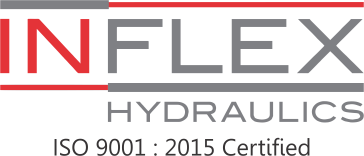When it comes to maintaining the integrity and performance of fluid transfer systems, the installation of hoses is just as important as the quality of the components themselves. At Inflex Hydraulics, we’ve spent years helping industries across oil & gas, chemical, marine, and power sectors select and install the right stainless steel flexible hose for their operations.
Whether you’re working with a stainless steel flex hose, ss flex hose, or stainless flexible hose, correct installation ensures safety, performance, and long-term reliability. In this guide, we’ve compiled expert-backed installation tips to help you make the most of your investment.
1. Choose the Right Hose for the Application
Before installation even begins, it’s essential to ensure you’re working with the correct type of stainless steel flexible hose. Not all hoses are created equal. Some are designed to handle high pressure, while others are ideal for corrosive environments or high-temperature conditions.
Ask yourself:
- Will the hose carry gas, liquid, or steam?
- What are the operating temperature and pressure ranges?
- Is there movement or vibration involved?
If you’re unsure, the team at Inflex Hydraulics can guide you in choosing the right SS flex hose or stainless steel flex hose based on your industry-specific requirements.
2. Allow for Proper Hose Movement
One of the most common mistakes we see in installations is a lack of flexibility allowance. A stainless steel flex hose is designed to flex, not to stretch, compress, or twist excessively. When improperly installed, hoses can become strained and eventually fail.
Installation Tip:
Ensure your hose has enough room to move naturally within the system. Use guides or supports to help maintain its intended path and avoid unnecessary stress on the fittings.
3. Avoid Torsion or Twisting
Torsion is the silent killer of flexible hoses. Twisting an SS flexible hose during installation can weaken the braid, increase internal stress, and drastically shorten the hose’s life.
To avoid this:
- Never install the hose by rotating it into a threaded fitting.
- Use a wrench to hold the fitting while tightening the connection.
- Consider swivel fittings for applications with rotational movement.
At Inflex Hydraulics, we recommend checking both ends of the stainless steel flexible hose for any signs of tension before final tightening.
4. Maintain Proper Bend Radius
Every stainless flexible hose has a minimum bend radius, which is the smallest radius it can be bent without damage. Exceeding this bend radius can lead to kinking, internal damage, or rupture.
Always refer to the manufacturer’s guidelines to maintain proper bending and avoid:
- Sharp bends near the hose fittings
- Over-tightening clamps or straps
- Excessively short hose lengths for the required routing
Pro Tip:
Use elbows or angled adapters to help redirect the hose path smoothly if space is limited.
Read More: Why Proper Selection of Hydraulic Valves Matters in System Design
5. Secure Hose Ends Correctly
Improper securing of hose ends often results in premature wear. When installing a stainless steel flex hose, make sure that the ends are properly aligned and not subjected to tension, pulling, or side loads.
Expert Insight from Inflex:
We recommend mounting the hose ends using appropriate clamps and brackets, especially in vertical installations, to relieve the fitting connections of unnecessary strain.
6. Inspect Before Pressurizing
Once your SS flex hose or stainless steel flexible hose is in place, never jump straight to full operating pressure. A visual inspection and slow-pressure test is a must.
Here’s what to check for:
- Correct alignment of fittings
- No visible twists, bulges, or bends
- Proper tightening of connections
- Adequate support and clamps
If using an SS flexible hose in high-pressure or critical environments, we recommend hydrostatic testing under controlled conditions.
Recommended Reading: How to Identify the Right Camlock Couplings for Your System Needs
7. Monitor Regularly for Wear and Tear
Even with perfect installation, environmental factors such as vibration, heat, and chemical exposure can wear down your stainless steel flexible hose over time.
Include the following in your maintenance routine:
- Visual inspection of the hose body and braid
- Check for fraying, discoloration, or leaks
- Inspect connections and surrounding equipment
- Replace worn or damaged hoses immediately
A properly installed and monitored stainless steel flex hose can last years, even in demanding environments.
8. Work With a Trusted Hose Partner
No matter how skilled your maintenance team is, working with an experienced partner like Inflex Hydraulics can take the pressure off your operations. We not only supply world-class stainless steel flexible hoses, but we also offer customization, expert installation guidance, and repair support.
Our clients count on us for:
- Fast turnarounds on customized hose assemblies
- Global delivery from Dubai to international destinations
- Expert recommendations tailored to industry-specific needs
Final Thoughts
Installing a stainless steel flex hose correctly isn’t just about fitting it into place—it’s about optimizing the entire fluid transfer system for longevity, safety, and efficiency. At Inflex Hydraulics, our team has helped clients across sectors reduce downtime, prevent leaks, and achieve better flow performance through precision installation and expert recommendations.
Whether you need an SS flex hose, a stainless flexible hose, or an SS flexible hose, we’ve got the inventory and the expertise to support your operations from start to finish.



